沙索产品介绍
- 格式:doc
- 大小:29.00 KB
- 文档页数:2
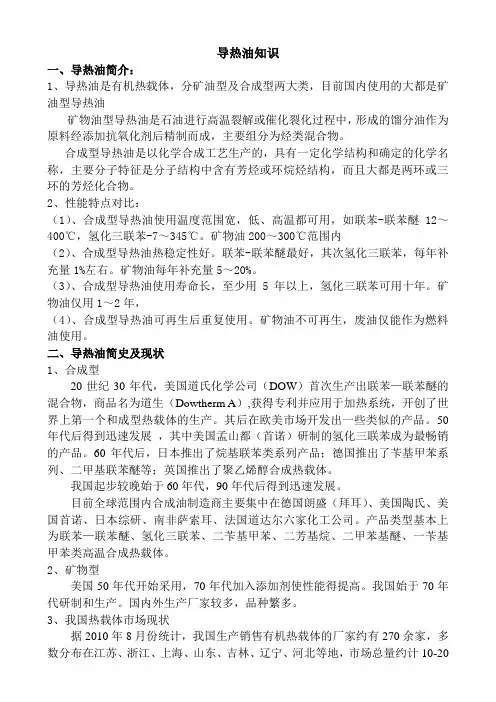
导热油知识一、导热油简介:1、导热油是有机热载体,分矿油型及合成型两大类,目前国内使用的大都是矿油型导热油矿物油型导热油是石油进行高温裂解或催化裂化过程中,形成的馏分油作为原料经添加抗氧化剂后精制而成,主要组分为烃类混合物。
合成型导热油是以化学合成工艺生产的,具有一定化学结构和确定的化学名称,主要分子特征是分子结构中含有芳烃或环烷烃结构,而且大都是两环或三环的芳烃化合物。
2、性能特点对比:(1)、合成型导热油使用温度范围宽,低、高温都可用,如联苯-联苯醚12~400℃,氢化三联苯-7~345℃。
矿物油200~300℃范围内(2)、合成型导热油热稳定性好。
联苯-联苯醚最好,其次氢化三联苯,每年补充量1%左右。
矿物油每年补充量5~20%。
(3)、合成型导热油使用寿命长,至少用5年以上,氢化三联苯可用十年。
矿物油仅用1~2年,(4)、合成型导热油可再生后重复使用。
矿物油不可再生,废油仅能作为燃料油使用。
二、导热油简史及现状1、合成型20世纪30年代,美国道氏化学公司(DOW)首次生产出联苯—联苯醚的混合物,商品名为道生(Dowtherm A),获得专利并应用于加热系统,开创了世界上第一个和成型热载体的生产。
其后在欧美市场开发出一些类似的产品。
50年代后得到迅速发展,其中美国孟山都(首诺)研制的氢化三联苯成为最畅销的产品。
60年代后,日本推出了烷基联苯类系列产品;德国推出了苄基甲苯系列、二甲基联苯醚等;英国推出了聚乙烯醇合成热载体。
我国起步较晚始于60年代,90年代后得到迅速发展。
目前全球范围内合成油制造商主要集中在德国朗盛(拜耳)、美国陶氏、美国首诺、日本综研、南非萨索耳、法国道达尔六家化工公司。
产品类型基本上为联苯—联苯醚、氢化三联苯、二苄基甲苯、二芳基烷、二甲苯基醚、一苄基甲苯类高温合成热载体。
2、矿物型美国50年代开始采用,70年代加入添加剂使性能得提高。
我国始于70年代研制和生产。
国内外生产厂家较多,品种繁多。
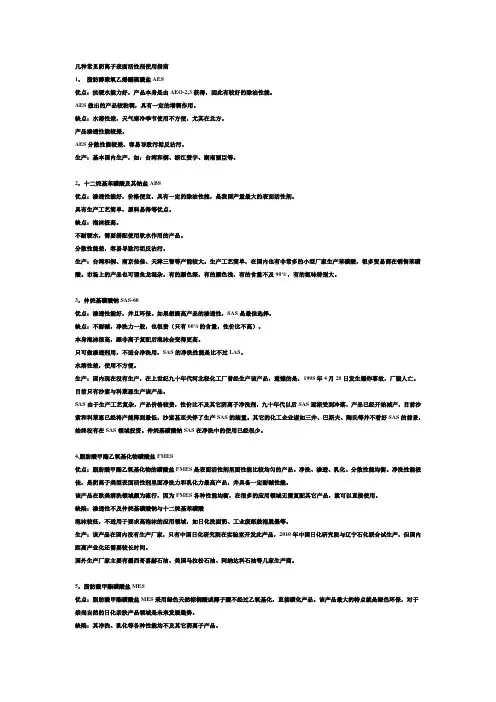
几种常见阴离子表面活性剂使用指南1,脂肪醇聚氧乙烯醚硫酸盐AES优点:抗硬水能力好,产品本身是由AEO-2,3获得,因此有较好的除油性能。
AES做出的产品较粘稠,具有一定的增稠作用。
缺点:水溶性差,天气寒冷季节使用不方便,尤其在北方。
产品渗透性能较差。
AES分散性能较差,容易导致污垢反沾污。
生产:基本国内生产,如:台湾和桐、浙江赞宇、湖南丽臣等。
2,十二烷基苯磺酸及其钠盐ABS优点:渗透性能好,价格便宜,具有一定的除油性能,是我国产量最大的表面活性剂。
具有生产工艺简单,原料易得等优点。
缺点:泡沫极高。
不耐硬水,需要搭配使用软水作用的产品。
分散性能差,容易导致污垢反沾污。
生产:台湾和桐、南京佳佳、天津三智等产能较大。
生产工艺简单,在国内也有非常多的小型厂家生产苯磺酸,很多贸易商在销售苯磺酸。
市场上的产品也可谓鱼龙混杂。
有的颜色深,有的颜色浅,有的含量不及90%,有的氨味特别大。
3,仲烷基磺酸钠SAS-60优点:渗透性能好,并且环保。
如果想提高产品的渗透性,SAS是最佳选择。
缺点:不耐碱,净洗力一般,也很贵(只有60%的含量,性价比不高)。
本身泡沫很高,跟非离子复配后泡沫会变得更高。
只可做渗透剂用,不适合净洗用,SAS的净洗性能是比不过LAS。
水溶性差,使用不方便。
生产:国内现在没有生产,在上世纪九十年代河北轻化工厂曾经生产该产品,遗憾的是,1998年4月28日发生爆炸事故,厂毁人亡。
目前只有沙索与科莱恩生产该产品。
SAS由于生产工艺复杂,产品价格较贵,性价比不及其它阴离子净洗剂,九十年代以后SAS逐渐受到冷落,产品已经开始减产,目前沙索和科莱恩已经将产能降到最低,沙索甚至关停了生产SAS的装置。
其它的化工企业诸如三井、巴斯夫、陶氏等并不看好SAS的前景,始终没有在SAS领域投资。
仲烷基磺酸钠SAS在净洗中的使用已经很少。
4,脂肪酸甲酯乙氧基化物磺酸盐FMES优点:脂肪酸甲酯乙氧基化物的磺酸盐FMES是表面活性剂里面性能比较均匀的产品。
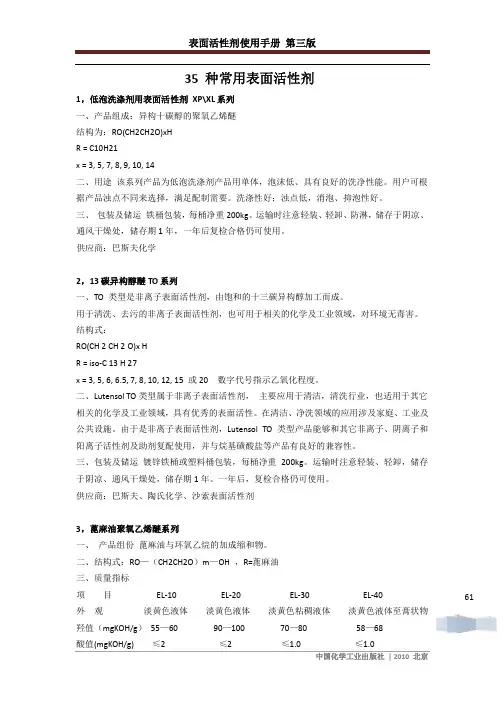
6135 种常用表面活性剂1,低泡洗涤剂用表面活性剂 XP\XL 系列一、产品组成:异构十碳醇的聚氧乙烯醚结构为:RO(CH2CH2O)xHR = C10H21x = 3, 5, 7, 8, 9, 10, 14二、用途 该系列产品为低泡洗涤剂产品用单体,泡沫低、具有良好的洗净性能。
用户可根据产品浊点不同来选择,满足配制需要。
洗涤性好;浊点低,消泡、抑泡性好。
三、 包装及储运 铁桶包装,每桶净重200kg 。
运输时注意轻装、轻卸、防淋,储存于阴凉、通风干燥处,储存期1年,一年后复检合格仍可使用。
供应商:巴斯夫化学2,13碳异构醇醚TO 系列一、TO 类型是非离子表面活性剂,由饱和的十三碳异构醇加工而成。
用于清洗、去污的非离子表面活性剂,也可用于相关的化学及工业领域,对环境无毒害。
结构式:RO(CH 2 CH 2 O)x HR = iso-C 13 H 27x = 3, 5, 6, 6.5, 7, 8, 10, 12, 15 或20 数字代号指示乙氧化程度。
二、Lutensol TO 类型属于非离子表面活性剂, 主要应用于清洁,清洗行业,也适用于其它相关的化学及工业领域,具有优秀的表面活性。
在清洁、净洗领域的应用涉及家庭、工业及公共设施。
由于是非离子表面活性剂,Lutensol TO 类型产品能够和其它非离子、阴离子和阳离子活性剂及助剂复配使用,并与烷基磺酸盐等产品有良好的兼容性。
三、包装及储运 镀锌铁桶或塑料桶包装,每桶净重200kg 。
运输时注意轻装、轻卸,储存于阴凉、通风干燥处,储存期1年。
一年后,复检合格仍可使用。
供应商:巴斯夫、陶氏化学、沙索表面活性剂3,蓖麻油聚氧乙烯醚系列一、 产品组份 蓖麻油与环氧乙烷的加成缩和物。
二、结构式:RO —(CH2CH2O )m —OH ,R=蓖麻油三、质量指标项 目 EL-10 EL-20 EL-30 EL-40外 观 淡黄色液体 淡黄色液体 淡黄色粘稠液体 淡黄色液体至膏状物 羟值(mgKOH/g ) 55—60 90—100 70—80 58—68酸值(mgKOH/g) ≤2 ≤2 ≤1.0 ≤1.062浊点(1%水溶液) -- -- -- ≥85PH(1%水溶液) 5—7 5—7 5—7 5—7水份(%) ≤0.5 ≤0.5 ≤0.5 ≤0.5四、用途 本品为淡黄色透明油状液体,溶于乙醇、油酸、矿物油、甲乙酮、三氯乙烯,部分溶于硬脂酸丁酯、花生油,可分散于水中,耐硬水、酸和无机盐,具有优良的乳化、抗静电性能。
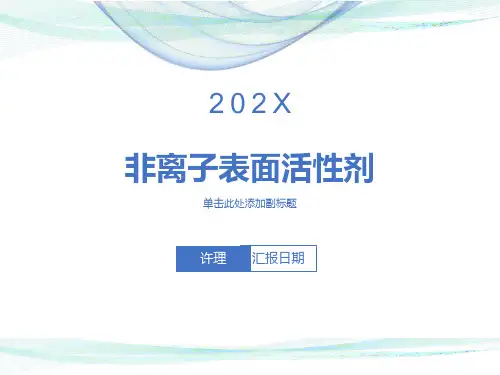
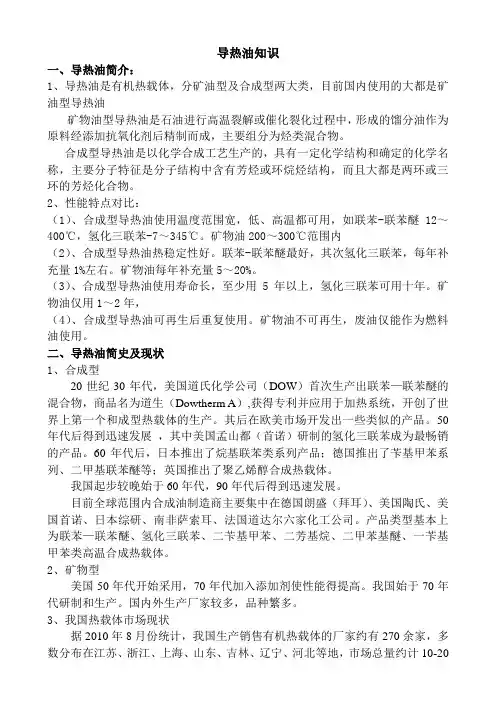
导热油知识一、导热油简介:1、导热油是有机热载体,分矿油型及合成型两大类,目前国内使用的大都是矿油型导热油矿物油型导热油是石油进行高温裂解或催化裂化过程中,形成的馏分油作为原料经添加抗氧化剂后精制而成,主要组分为烃类混合物。
合成型导热油是以化学合成工艺生产的,具有一定化学结构和确定的化学名称,主要分子特征是分子结构中含有芳烃或环烷烃结构,而且大都是两环或三环的芳烃化合物。
2、性能特点对比:(1)、合成型导热油使用温度范围宽,低、高温都可用,如联苯-联苯醚12~400℃,氢化三联苯-7~345℃。
矿物油200~300℃范围内(2)、合成型导热油热稳定性好。
联苯-联苯醚最好,其次氢化三联苯,每年补充量1%左右。
矿物油每年补充量5~20%。
(3)、合成型导热油使用寿命长,至少用5年以上,氢化三联苯可用十年。
矿物油仅用1~2年,(4)、合成型导热油可再生后重复使用。
矿物油不可再生,废油仅能作为燃料油使用。
二、导热油简史及现状1、合成型20世纪30年代,美国道氏化学公司(DOW)首次生产出联苯—联苯醚的混合物,商品名为道生(Dowtherm A),获得专利并应用于加热系统,开创了世界上第一个和成型热载体的生产。
其后在欧美市场开发出一些类似的产品。
50年代后得到迅速发展,其中美国孟山都(首诺)研制的氢化三联苯成为最畅销的产品。
60年代后,日本推出了烷基联苯类系列产品;德国推出了苄基甲苯系列、二甲基联苯醚等;英国推出了聚乙烯醇合成热载体。
我国起步较晚始于60年代,90年代后得到迅速发展。
目前全球范围内合成油制造商主要集中在德国朗盛(拜耳)、美国陶氏、美国首诺、日本综研、南非萨索耳、法国道达尔六家化工公司。
产品类型基本上为联苯—联苯醚、氢化三联苯、二苄基甲苯、二芳基烷、二甲苯基醚、一苄基甲苯类高温合成热载体。
2、矿物型美国50年代开始采用,70年代加入添加剂使性能得提高。
我国始于70年代研制和生产。
国内外生产厂家较多,品种繁多。

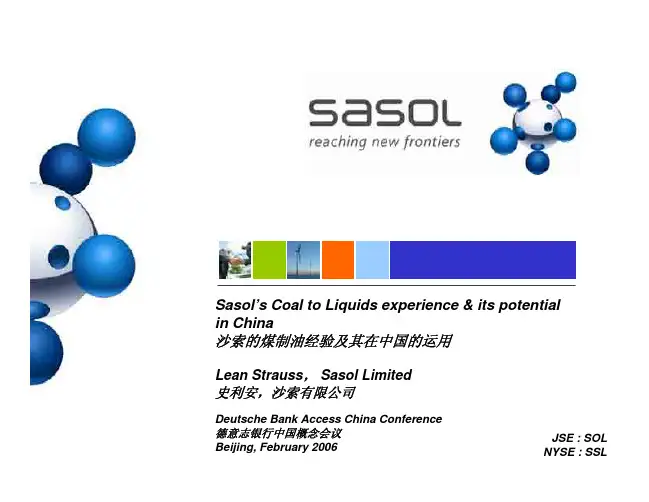
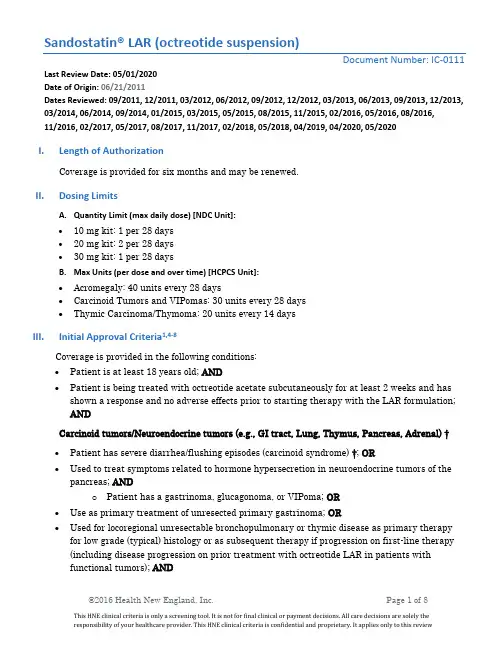
Sandostatin® LAR (octreotide suspension)Document Number: IC-0111 Last Review Date: 05/01/2020Date of Origin: 06/21/2011Dates Reviewed: 09/2011, 12/2011, 03/2012, 06/2012, 09/2012, 12/2012, 03/2013, 06/2013, 09/2013, 12/2013, 03/2014, 06/2014, 09/2014, 01/2015, 03/2015, 05/2015, 08/2015, 11/2015, 02/2016, 05/2016, 08/2016, 11/2016, 02/2017, 05/2017, 08/2017, 11/2017, 02/2018, 05/2018, 04/2019, 04/2020, 05/2020I.Length of AuthorizationCoverage is provided for six months and may be renewed.II.Dosing LimitsA.Quantity Limit (max daily dose) [NDC Unit]:∙10 mg kit: 1 per 28 days∙20 mg kit: 2 per 28 days∙30 mg kit: 1 per 28 daysB.Max Units (per dose and over time) [HCPCS Unit]:∙Acromegaly: 40 units every 28 days∙Carcinoid Tumors and VIPomas: 30 units every 28 days∙Thymic Carcinoma/Thymoma:20 units every 14 daysIII.Initial Approval Criteria1,4-8Coverage is provided in the following conditions:∙Patient is at least 18 years old; AND∙Patient is being treated with octreotide acetate subcutaneously for at least 2 weeks and has shown a response and no adverse effects prior to starting therapy with the LAR formulation;ANDCarcinoid tumors/Neuroendocrine tumors (e.g., GI tract, Lung, Thymus, Pancreas, Adrenal) †∙Patient has severe diarrhea/flushing episodes (carcinoid syndrome) †; OR∙Used to treat symptoms related to hormone hypersecretion in neuroendocrine tumors of the pancreas; ANDo Patient has a gastrinoma, glucagonoma, or VIPoma; OR∙Use as primary treatment of unresected primary gastrinoma; OR∙Used for locoregional unresectable bronchopulmonary or thymic disease as primary therapy for low grade (typical) histology or as subsequent therapy if progression on first-line therapy(including disease progression on prior treatment with octreotide LAR in patients withfunctional tumors); ANDo Used for management of hormone symptoms and/or somatostatin receptor positive disease determined by imaging (i.e., 68Ga-dotatate imaging PET/CT or PET/MRI orsomatostatin receptor scintigraphy [octreotide scan]); OR∙Patient has distant metastatic bronchopulmonary or thymic disease; ANDo Used for somatostatin receptor positive disease and/or symptomatic hormonal disease if clinically significant tumor burden and low grade (typical) histology OR evidence ofprogression OR intermediate grade (atypical histology); ANDUsed as primary therapy or as subsequent therapy if progression on first-line therapy; ORo Used for somatostatin receptor positive disease and/or hormonal symptoms if asymptomatic with low tumor burden and low grade (typical histology); OR o Used for somatostatin receptor positive disease and/or chronic cough/dyspnea with multiple lung nodules or tumorlets and evidence of diffuse idiopathic pulmonaryneuroendocrine cell hyperplasia (DIPNECH); OR∙Used for the management of locoregional advanced or metastatic disease of the gastrointestinal tract; ANDo Patient is asymptomatic with a low tumor burden; ORo Patient with a clinically significant tumor burden; ORo Patient has disease progression and is not already receiving octreotide LAR; ORo Patient has disease progression with functional tumors and will be continuing treatment with octreotide LAR; OR∙Used for tumor control of locoregional advanced and/or metastatic neuroendocrine tumors of the pancreas (***NOTE: for insulinoma ONLY, patient must have somatostatin-receptor positive disease); ANDo Patient is asymptomatic with a low tumor burden and stable disease; ORo Patient is symptomatic with a clinically significant tumor burden; ORo Patient has clinically significant progression and is not already receiving octreotide LAR; OR∙Used for locally unresectable or distant metastatic pheochromocytoma or paraganglioma if somatostatin receptor-positive and symptomaticDiarrhea associated with Vasoactive intestinal peptide tumors (VIPomas) [pancreatic neuroendocrine (islet cell) tumor, insulinoma, glucagonoma, somatostatinoma, and gastrinoma] †∙Patient has profuse watery diarrheaAcromegaly †∙Patient diagnosis confirmed by elevated (age-adjusted) or equivocal serum IGF-1 as well as inadequate suppression of GH after a glucose load; AND∙Patient has documented inadequate response to surgery and/or radiotherapy or it is not an option for the patient; AND∙Used as long-term maintenance therapy; AND∙Patient’s tumor has been visualized on imaging studies (i.e., MRI or CT-scan); AND∙Baseline growth hormone (GH) and IGF-I blood levels (renewal will require reporting of current levels)Thymic Carcinomas/Thymomas ‡∙Used as second-line therapy with or without prednisone; ANDo Patient has unresectable disease following first-line chemotherapy for potentially resectable locally advanced disease, solitary metastasis, or ipsilateral pleuralmetastasis; ORo Patient has extrathoracic metastatic disease†FDA Approved Indication(s); ‡Compendia recommended indication(s)IV.Renewal Criteria1,4-8∙Patient continues to meet indication-specific relevant criteria such as concomitant therapy requirements (not including prerequisite therapy), performance status, etc.identified insection III; AND∙Absence of unacceptable toxicity from the drug. Examples of unacceptable toxicity include the following: cholelithiasis and complications of cholelithiasis (i.e.cholecystitis, cholangitis,pancreatitis), hyperglycemia, hypoglycemia, hypothyroidism, sinus bradycardia, cardiacarrhythmias, cardiac conduction abnormalities, depressed vitamin B12 levels, etc.; AND ∙Disease response with improvement in patient’s symptoms i ncluding reduction in symptomatic episodes (such as diarrhea, rapid gastric dumping, flushing, bleeding, etc.)and/or stabilization of glucose levels and/or decrease in size of tumor or tumor spread; ORo Acromegaly ONLY: Disease response as indicated by an improvement in signs and symptoms compared to baseline; AND▪Reduction of growth hormone (GH) from pre-treatment baseline; OR▪Age-adjusted normalization of serum IGF-1; ORo Neuroendocrine tumors (gastrointestinal tract, bronchopulmonary, thymus, or pancreas) ONLY: Patient has had disease progression and therapy will be continued in patientswith functional tumors.V.Dosage/Administration1,7VI.Billing Code/Availability InformationHCPCS Code:∙J2353- Injection, octreotide, depot form for intramuscular injection, 1 mg: 1 mg = 1 billable unitNDC:∙10 mg single-use kit: 00078-0811-XX∙20 mg single-use kit: 00078-0818-XX∙30 mg single-use kit: 00078-0825-XXVII.References1.Sandostatin LAR [package insert]. East Hanover, NJ; Novartis Pharmaceuticals Corporation;April 2019. Accessed March 2020.2.Giustina A, Chanson P, Kleinberg D, et al. Expert consensus document: A consensus on themedical treatment of acromegaly. Nat Rev Endocrinol. 2014 Apr; 10(4):243-8. doi:10.1038/nrendo.2014.21. Epub 2014 Feb 25.3.Katznelson L, Laws ER Jr, Melmed S, et al. Acromegaly: an endocrine society clinicalpractice guideline. J Clin Endocrinol Metab. 2014 Nov; 99(11):3933-51. doi: 10.1210/jc.2014-2700. Epub 2014 Oct 30.4.Referenced with permission from the NCCN Drugs & Biologics Compendium (NCCNCompendium®) for Octreotide acetate (LAR). National Comprehensive Cancer Network,2020. The NCCN Compendium® is a derivative work of the NCCN Guidelines®. NATIONAL COMPREHENSIVE CANCER NETWORK®, NCCN®, and NCCN GUIDELINES® aretrademarks owned by the National Comprehensive Cancer Network, Inc. To view the mostrecent and complete version of the Compendium, go online to . Accessed March2020.ncranjan I, Atkinson AB & Sandostatin® LAR® Group#. Results of a EuropeanMulticentre Study with Sandostatin® LAR® in Acromegalic Patients. Pituitary1, 105–114;Published: June 1999. https:///10.1023/A:1009980404404.6.Rubin J, Ajani J, Schirmer W, et al. Octreotide Acetate Long-Acting Formulation VersusOpen-Label Subcutaneous Octreotide Acetate in Malignant Carcinoid Syndrome. J ClinOncol, 17 (2), 600-6; Feb 1999. PMID: 10080605. DOI: 10.1200/JCO.1999.17.2.600.7.Longo F, De Filippis L, Zivi A, et al. Efficacy and Tolerability of Long-Acting Octreotide inthe Treatment of Thymic Tumors: Results of a Pilot Trial. Am J Clin Oncol, 35 (2), 105-9;April 2012. PMID: 21325939. DOI: 10.1097/COC.0b013e318209a8f8.8.Referenced with permission from the NCCN Drugs & Biologics Compendium (NCCNCompendium®) Thymomas and Thymic Carcinomas. Version 1.2020. NationalComprehensive Cancer Network, 2019. The NCCN Compendium® is a derivative work of the NCCN Guidelines®. NATIONAL COMPREHENSIVE CANCER NETWORK®, NCCN®, and NCCN GUIDELINES® are trademarks owned by the National Comprehensive CancerNetwork, Inc.” To view the most rec ent and complete version of the Compendium, go online to . Accessed March 2020.9.Palmetto GBA. Local Coverage Determination (LCD): Octreotide Acetate for InjectableSuspension (Sandostatin LAR depot) (L33438). Centers for Medicare & Medicaid Services,Inc. Updated on 10/14/2019 with effective date 10/24/2019. Accessed March 2020.10.Palmetto GBA. Local Coverage Article: Billing and Coding: Octreotide Acetate for InjectableSuspension (Sandostatin LAR® depot) (A56531). Centers for Medicare & Medicaid Services, Inc. Updated on 10/08/2019 with effective date 10/17/2019. Accessed March 2020. Appendix 1 – Covered Diagnosis CodesAppendix 2 – Centers for Medicare and Medicaid Services (CMS)Medicare coverage for outpatient (Part B) drugs is outlined in the Medicare Benefit Policy Manual (Pub. 100-2), Chapter 15, §50 Drugs and Biologicals. In addition, National Coverage Determination (NCD), Local Coverage Determinations (LCDs), and Articles may exist and compliance with these policies is required where applicable. They can be found at: /medicare-coverage-database/search/advanced-search.aspx. Additional indications may be covered at the discretion of the health plan.Medicare Part B Covered Diagnosis Codes (applicable to existing NCD/LCD/Article):。
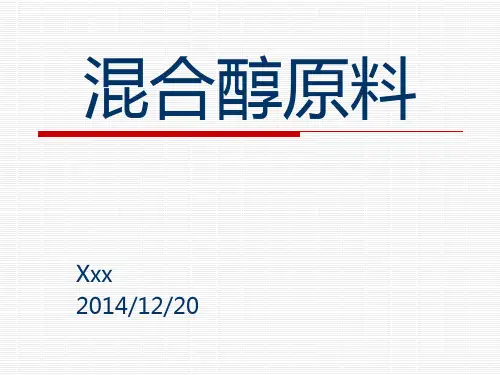
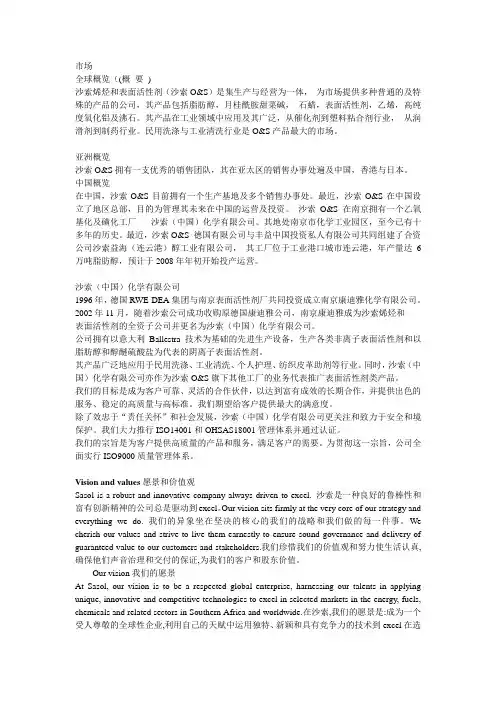
市场全球概览((概要)沙索烯烃和表面活性剂(沙索O&S)是集生产与经营为一体,为市场提供多种普通的及特殊的产品的公司,其产品包括脂肪醇,月桂酰胺甜菜碱,石蜡,表面活性剂,乙烯,高纯度氧化铝及沸石。
其产品在工业领域中应用及其广泛,从催化剂到塑料粘合剂行业,从润滑剂到制药行业。
民用洗涤与工业清洗行业是O&S产品最大的市场。
亚洲概览沙索O&S拥有一支优秀的销售团队,其在亚太区的销售办事处遍及中国,香港与日本。
中国概览在中国,沙索O&S目前拥有一个生产基地及多个销售办事处。
最近,沙索O&S在中国设立了地区总部,目的为管理其未来在中国的运营及投资。
沙索O&S在南京拥有一个乙氧基化及磺化工厂-- 沙索(中国)化学有限公司。
其地处南京市化学工业园区,至今已有十多年的历史。
最近,沙索O&S 德国有限公司与丰益中国投资私人有限公司共同组建了合资公司沙索益海(连云港)醇工业有限公司,其工厂位于工业港口城市连云港,年产量达6万吨脂肪醇,预计于2008年年初开始投产运营。
沙索(中国)化学有限公司1996年,德国RWE-DEA集团与南京表面活性剂厂共同投资成立南京康迪雅化学有限公司。
2002年11月,随着沙索公司成功收购原德国康迪雅公司,南京康迪雅成为沙索烯烃和表面活性剂的全资子公司并更名为沙索(中国)化学有限公司。
公司拥有以意大利Ballestra技术为基础的先进生产设备,生产各类非离子表面活性剂和以脂肪醇和醇醚硫酸盐为代表的阴离子表面活性剂。
其产品广泛地应用于民用洗涤、工业清洗、个人护理、纺织皮革助剂等行业。
同时,沙索(中国)化学有限公司亦作为沙索O&S旗下其他工厂的业务代表推广表面活性剂类产品。
我们的目标是成为客户可靠、灵活的合作伙伴,以达到富有成效的长期合作,并提供出色的服务、稳定的高质量与高标准。
我们期望给客户提供最大的满意度。
除了效忠于“责任关怀”和社会发展,沙索(中国)化学有限公司更关注和致力于安全和境保护。
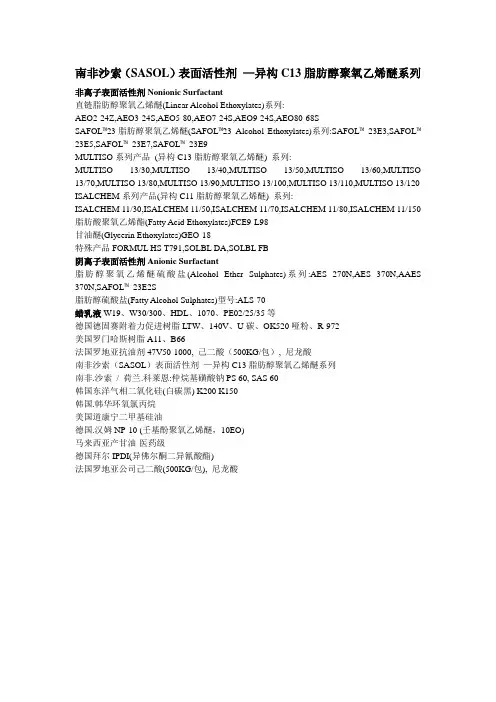
南非沙索(SASOL)表面活性剂—异构C13脂肪醇聚氧乙烯醚系列非离子表面活性剂Nonionic Surfactant直链脂肪醇聚氧乙烯醚(Linear Alcohol Ethoxylates)系列:AEO2-24Z,AEO3-24S,AEO5-80,AEO7-24S,AEO9-24S,AEO80-68SSAFOL™23脂肪醇聚氧乙烯醚(SAFOL™23 Alcohol Ethoxylates)系列:SAFOL™23E3,SAFOL™23E5,SAFOL™23E7,SAFOL™23E9MULTISO系列产品(异构C13脂肪醇聚氧乙烯醚) 系列:MULTISO 13/30,MULTISO 13/40,MULTISO 13/50,MULTISO 13/60,MULTISO 13/70,MULTISO 13/80,MULTISO 13/90,MULTISO 13/100,MULTISO 13/110,MULTISO 13/120 ISALCHEM系列产品(异构C11脂肪醇聚氧乙烯醚) 系列:ISALCHEM 11/30,ISALCHEM 11/50,ISALCHEM 11/70,ISALCHEM 11/80,ISALCHEM 11/150 脂肪酸聚氧乙烯酯(Fatty Acid Ethoxylates)FCE9-L98甘油醚(Glycerin Ethoxylates)GEO-18特殊产品FORMUL HS T791,SOLBL DA,SOLBL FB阴离子表面活性剂Anionic Surfactant脂肪醇聚氧乙烯醚硫酸盐(Alcohol Ether Sulphates)系列:AES 270N,AES 370N,AAES 370N,SAFOL™23E2S脂肪醇硫酸盐(Fatty Alcohol Sulphates)型号:ALS-70蜡乳液W19、W30/300、HDL、1070、PE02/25/35等德国德固赛附着力促进树脂LTW、140V、U碳、OK520哑粉、R-972美国罗门哈斯树脂A11、B66法国罗地亚抗油剂47V50-1000, 己二酸(500KG/包), 尼龙酸南非沙索(SASOL)表面活性剂—异构C13脂肪醇聚氧乙烯醚系列南非.沙索/ 荷兰.科莱恩:仲烷基磺酸钠PS 60, SAS 60韩国东洋气相二氧化硅(白碳黑) K200 K150韩国.韩华环氧氯丙烷美国道康宁二甲基硅油德国.汉姆NP-10 (壬基酚聚氧乙烯醚,10EO)马来西亚产甘油-医药级德国拜尔IPDI(异佛尔酮二异氰酸酯)法国罗地亚公司己二酸(500KG/包), 尼龙酸详细说明:一、SASOL脂肪醇:1、直链天然醇---Nacol 14-98 系列、NAFOL系列2、支链异构醇---Isaclehm 145,SASOL 233、格尔伯特醇系列---ISOFOL 12/16/18T/20 .4、 Nafol 20+---造纸消泡剂、皮革加脂剂二、SASOL脂肪酸系列---格尔伯特酸 Isocarb12、Isocarb24三、SASOL非离子表面活性剂1、 SASOL EN系列---用作硅油乳化剂、清洗剂、渗透剂2、 MULTISO 13系列---高效硅油乳化剂、脱脂剂、清洗剂。
化 学 品 安 全 技 术 说 明 书Ethylol 95版本 1.00 修订日期 08.03.2019打印日期 12.03.2019 100000001873 1/15部分 一 化学品及企业标识产品鉴别人 贸易名称 Ethylol 95 产品代码2050化学文摘登记号(CAS No.)64-17-5有关的确定了的物质或混合物的用途和建议不适合的用途 用途气溶胶推进剂的原料。
油墨添加剂 工业用生产者或供应商的详情 制造商或供应商名称 Sasol Chemicals, a division of Sasol South Africa Ltd 地址Sasol Place, 50 Katherine Street Sandton 2090South Africa 电话号码 +27103445000电子邮件地址 *************************** 供应商的详细情况 沙索(中国)化学有限公司 市化学工业园区, 南京 方水路68号 210047 China电话号码 +86 25 5839 1111 电子邮件地址*****************化 学 品 安 全 技 术 说 明 书Ethylol 95版本 1.00 修订日期 08.03.2019打印日期 12.03.2019 100000001873 2/15应急电话号码应急咨询电话+44 (0)1235 239 670 (Europe, Israel, Africa, Americas) +44(0)1235 239 671 (Middle East, Arabic African countries) +65 3158 1074 (Asia Pacific) +86 10 5100 3039 (China 中国) +27 (0)17 610 4444 (South Africa) 0800 112 890 RSA-Local only +61 (2) 8014 4558 (Australia)部分 二 危险性概述物质或混合物的分类GHS 危险性类别分类GHS 分类和标签: 遵从GB 13690, GB 15258 和 GB 30000.2 ~ GB 30000.29 (GHS 2011)易燃液体 类别 2眼损伤/刺激类别 2GHS 标签要素象形图:信号词: 危险化 学 品 安 全 技 术 说 明 书Ethylol 95版本 1.00 修订日期 08.03.2019打印日期 12.03.2019 100000001873 3/15危险性说明 : H225 高度易燃液体和蒸气。
涂料及色浆用低泡润湿剂 - MARLOX ® 技术资料 Sasol Olefins & Surfactants GmbH Anckelmannsplatz 1, 20537 HamburgTelephone: +49 (0)40 63684-1000 Fax: ++49 (0)40 63684-3700 info@ Geschäftsführer: Fleetwood Rawstorne Grobler Sitz der Gesellschaft: Hamburg Registergericht: Amtsgericht Hamburg HRB 78474动态泡沫性能不同润湿剂的泡沫高度比较测试仪器:Kruess DFA 100,25°C ,1克/升MARLOX ® 系列可以在短时间内自动消除配方 中的泡沫。
而常规润湿剂的泡沫会长时间保留在配方中。
这些泡沫对配方体系会产生消极影响。
技术信息及样品: 产品销售及价格信息: 沙索(中国)化学有限公司 沙索(中国)化学有限公司 虞惟俊 章劲梅中国江苏南京化学工业园区中国江苏南京化学工业园区 方水路68号,邮编210047 方水路68号,邮编210047 电话:025-5839 1111-2304 电话:025-5839 1111-1991weijun.yu@ Jinmei.zhang@O&S 国)化学有限公司基于实验数据和经验编写,仅限于阅读参考使用。
在此郑重声明沙索(中国)对产品的使用或应用,不承担任何连带责任或其它任何责任。
沙索(中国)对本文中的信息不承担任何义务或责任,也不提供担保,包括对专利侵权,与使用这些信息、产品有关的伤害的责任及产品是否满足要求。
关于产品的安全和使用信息,请参阅相关的产品安全技术说明书。
沙索氧化硅氧化铝
摘要:
1.沙索
2.氧化硅
3.氧化铝
正文:
1.沙索
沙索(Sasol)是一家南非的化工企业,成立于1950 年。
公司主要业务为生产和销售化工产品,其中以合成燃料和化工原料为主。
沙索公司通过先进的技术,将煤炭转化为合成燃料和化工产品,为全球市场提供多样化的解决方案。
此外,沙索还涉足矿产资源开发、能源开发等业务领域。
2.氧化硅
氧化硅(SiO2)是一种常见的无机化合物,也称为二氧化硅。
它是一种无色、透明的晶体,具有很高的熔点。
氧化硅广泛应用于玻璃、陶瓷、水泥等产业。
在玻璃生产中,氧化硅作为主要成分,可以提高玻璃的硬度和耐热性能。
在陶瓷制品中,氧化硅具有良好的抗高温性能和化学稳定性。
此外,氧化硅还用于制作光纤、电子元器件等高科技产品。
3.氧化铝
氧化铝(Al2O3)是一种常见的金属氧化物,也称为三氧化二铝。
它是一种高熔点、高硬度的晶体,具有很好的耐磨性能。
氧化铝广泛应用于工业生产中,如陶瓷、磨料、耐火材料等领域。
在陶瓷制品中,氧化铝可以提高制品的硬度、强度和抗磨损性能。
在磨料领域,氧化铝具有很高的磨削效率,可用于
砂轮、砂纸等磨具的制作。
此外,氧化铝还具有良好的高温绝缘性能,可用于制作电子元器件。
综上所述,沙索是一家以生产合成燃料和化工产品为主的南非化工企业。
产 品 技 术 资 料ISOFOL®特定支链位置格尔伯特醇ISOFOL® 是 SASOL 公司特定支链位置饱和伯醇的注册商标。
此系列醇的化学描述为 2-烷基-1 烷醇, 通称为格尔伯特醇。
图表 1:格尔伯特醇结构CH 3 ( CH 2 ) n CH 3 ( CH 2 ) n+ OH2n = 3, 5, 7, 9, 11, 13, 15图表 2:格尔伯特醇的熔点脂肪醇熔点10080 直链脂肪醇 60熔点 [℃]40 油醇 20 格尔伯特醇0-20 10 12 14 16 18 20 22 24 26 28 30 32 34碳链长度Sasol-PIS-CH-ISOFOL®Page 1 of 5Sasol (China) Chemical Co., Ltd.68 Fang Shui Road, Chemical Industry Park, Nanjing, China 210047 Telephone: (86) 25 5839 1111 Facsimile: (86) 25 5839 2222 E-mail: sasol.china@ 沙索(中国)化学有限公司南京化学工业园区方水路 68 号 邮编:210047 电话: (86)25 5839 1111 传真: (86)25 5839 2222 电子邮件:sasol.china@ ISOFOL®特定支链位置格尔伯特醇C12-24 ISOFOL® 醇在室温下是液态,对应碳数的饱和脂肪醇都是固体,对应碳数的不饱和脂肪 醇在 10 ℃左右开始固化。
C12-18 ISOFOL® 醇即使在 0 ℃以下仍然保持液态。
ISOFOL® 醇具有饱和脂肪醇的特性,即优异的抗氧化和色泽稳定性。
没有不饱和醇的腐臭气味。
由于产品特殊的结构,影响着它的极性和粘度,使其拥有出色的溶解度和溶解其他物质的潜力。
南非沙索(SASOL)表面活性剂—异构C13脂肪醇聚氧乙烯醚系列
非离子表面活性剂Nonionic Surfactant
直链脂肪醇聚氧乙烯醚(Linear Alcohol Ethoxylates)系列:
AEO2-24Z,AEO3-24S,AEO5-80,AEO7-24S,AEO9-24S,AEO80-68S
SAFOL™23脂肪醇聚氧乙烯醚(SAFOL™23 Alcohol Ethoxylates)系列:SAFOL™23E3,SAFOL™23E5,SAFOL™23E7,SAFOL™23E9
MULTISO系列产品(异构C13脂肪醇聚氧乙烯醚) 系列:
MULTISO 13/30,MULTISO 13/40,MULTISO 13/50,MULTISO 13/60,MULTISO 13/70,MULTISO 13/80,MULTISO 13/90,MULTISO 13/100,MULTISO 13/110,MULTISO 13/120 ISALCHEM系列产品(异构C11脂肪醇聚氧乙烯醚) 系列:
ISALCHEM 11/30,ISALCHEM 11/50,ISALCHEM 11/70,ISALCHEM 11/80,ISALCHEM 11/150 脂肪酸聚氧乙烯酯(Fatty Acid Ethoxylates)FCE9-L98
甘油醚(Glycerin Ethoxylates)GEO-18
特殊产品FORMUL HS T791,SOLBL DA,SOLBL FB
阴离子表面活性剂Anionic Surfactant
脂肪醇聚氧乙烯醚硫酸盐(Alcohol Ether Sulphates)系列:AES 270N,AES 370N,AAES 370N,SAFOL™23E2S
脂肪醇硫酸盐(Fatty Alcohol Sulphates)型号:ALS-70
蜡乳液W19、W30/300、HDL、1070、PE02/25/35等
德国德固赛附着力促进树脂LTW、140V、U碳、OK520哑粉、R-972
美国罗门哈斯树脂A11、B66
法国罗地亚抗油剂47V50-1000, 己二酸(500KG/包), 尼龙酸
南非沙索(SASOL)表面活性剂—异构C13脂肪醇聚氧乙烯醚系列
南非.沙索/ 荷兰.科莱恩:仲烷基磺酸钠PS 60, SAS 60
韩国东洋气相二氧化硅(白碳黑) K200 K150
韩国.韩华环氧氯丙烷
美国道康宁二甲基硅油
德国.汉姆NP-10 (壬基酚聚氧乙烯醚,10EO)
马来西亚产甘油-医药级
德国拜尔IPDI(异佛尔酮二异氰酸酯)
法国罗地亚公司己二酸(500KG/包), 尼龙酸
详细说明:
一、SASOL脂肪醇:
1、直链天然醇---Nacol 14-98 系列、NAFOL系列
2、支链异构醇---Isaclehm 145,SASOL 23
3、格尔伯特醇系列---ISOFOL 12/16/18T/20 .
4、 Nafol 20+---造纸消泡剂、皮革加脂剂
二、SASOL脂肪酸系列---格尔伯特酸 Isocarb12、Isocarb24
三、SASOL非离子表面活性剂
1、 SASOL EN系列---用作硅油乳化剂、清洗剂、渗透剂
2、 MULTISO 13系列---高效硅油乳化剂、脱脂剂、清洗剂。
3、 Marlox FK64---低泡清洗剂
4、 Marlox RT 系列---高效低泡的矿物油乳化剂,同时具有润滑性能。
5、 Marlowet 系列---抗强硬水的醇醚羧酸。
6、高效快速渗透剂---Isalchem 11/50,Isalchem 11/70,AO5-80,4秒钟,CMC值低,添加量小。
7、高性价比分散剂---AEO80-68S(片状),Emuldac AS80(粉体)。
8、 Marlowet 5056 ---电镀特殊添加剂。
四、SASOL酯类产品
1、 Isocarb Ester 1605
2、 Softenol 3829---食品级铝箔成型油。
3、特殊格尔伯醇酯系列。